BIO 148 Midterm 2

BIO 148 Midterm 2 Quiz
Prepare for your BIO 148 Midterm 2 with our comprehensive quiz! This quiz consists of 69 carefully crafted questions that cover key concepts in ecology, evolution, and behavior. Whether you're reviewing for your exam or seeking to enhance your understanding of biological principles, this quiz is designed to help you succeed.
- Test your knowledge on life histories and ecological communities.
- Explore topics like species interactions, reproduction, and succession.
- Understand the principles that govern biological diversity and ecosystem dynamics.
Which of the below is a key event in an organism's life history?
Survival to adulthood
Metamorphosis
All of the options are correct
Reproduction
What the key advantage of sexual reproduction compared to asexual reproduction?
Unequal contribution to gametes (isogamy) in sexual reproduction means that reproduction is less costly for one sex in a population, which can stop the population from going extinct
All else equal, sexually reproducing population increase more slowly than asexual ones, therefore reducing the chance of resource competition
Sexual reproduction requires individuals to find each other, which facilitates dispersal to new areas
Sexual reproduction creates genetic diversity whereas asexual reproduction creates genetic clones
What is the best definition of a complex life cycle?
A life cycle where an individual organism interacts with many other species
A life cycle where a species reproduces more than once before it dies
A life cycle in which an individual invests only in growth until it reproduces and dies
A life cycle involving at least two distinct morphological or physiological or habitat stages
In some species, life cycles can involve both sexual and asexual reproduction
True
False
How many chicks do birds tend raise each breeding season?
In most cases, birds will only raise two chicks per breeding season
The maximum number that they can successfully raise to fledglings
The maximum number of eggs a female can produce, which depends on her fat stores
Three times the number of adult birds tending to the nest
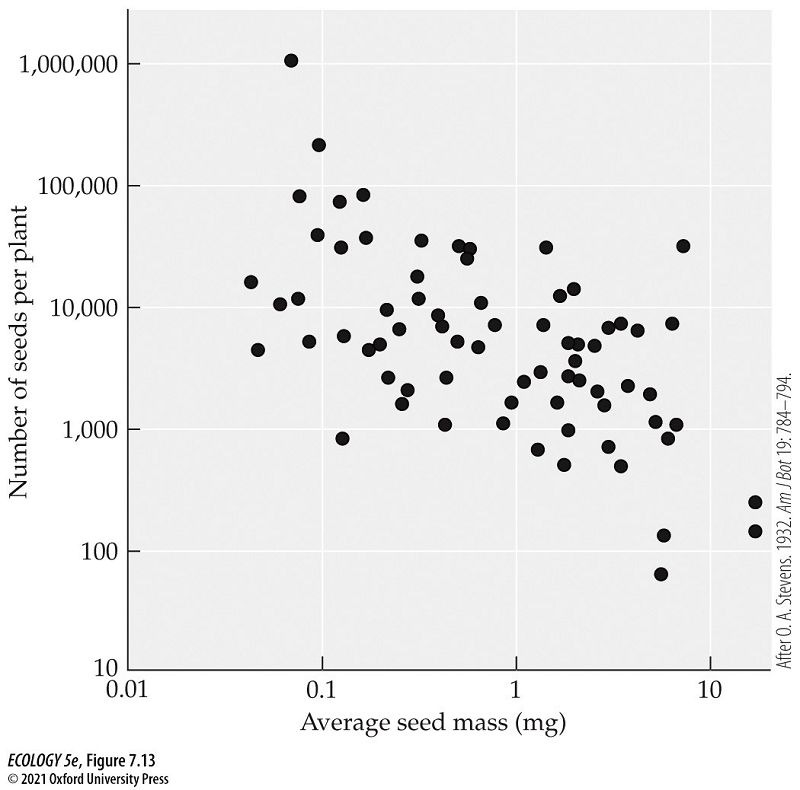
What is the key message from this figure?
Plants can produce lots of seeds if they have enough energy stores
Most plants produce a pretty large number of pretty large seeds
If a plant produces more seeds, each seed tends to be smaller
Only a few species produce large seeds
If a species is large, long-lived, provides parental care to its young, and produces large offspring, it would be classified as:
R-selected
K-selected
What are are three axes along which plant life histories are classified?
Photosynthetic pathway; water requirements; competitive ability
Stress tolerance; colonization ability; competitive ability
Maximum height; photosynthetic pathway; water requirements
Maximum height; photosynthetic pathway; stress tolerance
What is the difference between proximate and ultimate causes of behavior?
Proximate causes pertain to the adaptive significance of a behavior and ultimate causes are the immediate reason a behavior happened
Proximate causes are the short-term reason, whereas ultimate causes pertain to the adaptive significance of the behavior
What is the core principle of optimal foraging theory?
Animals forage in a way that reduces competition for food
Animals forage in a way that maximizes their energy intake
Animals forage in a way that maximizes energy intake per unit of time spent foraging
Animals forage in a way that minimizes predation risk
Which size group is best for group members?
Intermediate
Small
Large
What is a key determinant of monogamous vs. polyandrous/polygynous mating systems?
The ability of the non-choosy sex to monopolize individuals of the choosy sex
Monogamy happens in birds; polygyny and polyandry happen in mammals
Polyandry/polygyny involve little competition for mates within the non-choosy sex
Which is a disadvantage to living in groups?
Competition for food
Time spent fitting in to social hierarchy
All of the above
Disease risk
What is an ecological community?
All the species in an ecosystem
All the species in an ecosystem feeding on a certain type of prey
All options can be correct
All the species in an ecosystem belonging to a particular taxonomic group
What are the two components of species diversity?
Species richness and evenness
Species richness and extinction risk
Species richness and evolutionary distinctiveness
Species richness and identity
Why is sufficient sampling effort so important to surveying species richness in nature?
Because we also need to know a species' abundance (but species richness is found after very little surveying is done)
Because most species in a community are rare, so poor sampling effort will miss many species
Because species must be counted at least 3 times before they can be considered a part of the ecological community
Because scientific research papers must have a minimum number (i.e., 50) individuals counted before a survey can be published
What is a trophic level?
All the species in a food-web
The height within a forest that a species tends to live at
A group of species with the same level of hunger
A group of species that eat similar prey and are eaten by similar predators
What are indirect interactions in a food-web?
Where one species has an effect on another via its effect on a third species
Indirect interactions are always another name for competitive interactions
Indirect interactions are those that do not have a strong impact on the food-web
When one species interacts with the other but does not eat it
What is an example of a keystone species?
House sparrow
Sea otter
Lion
Hummingbird
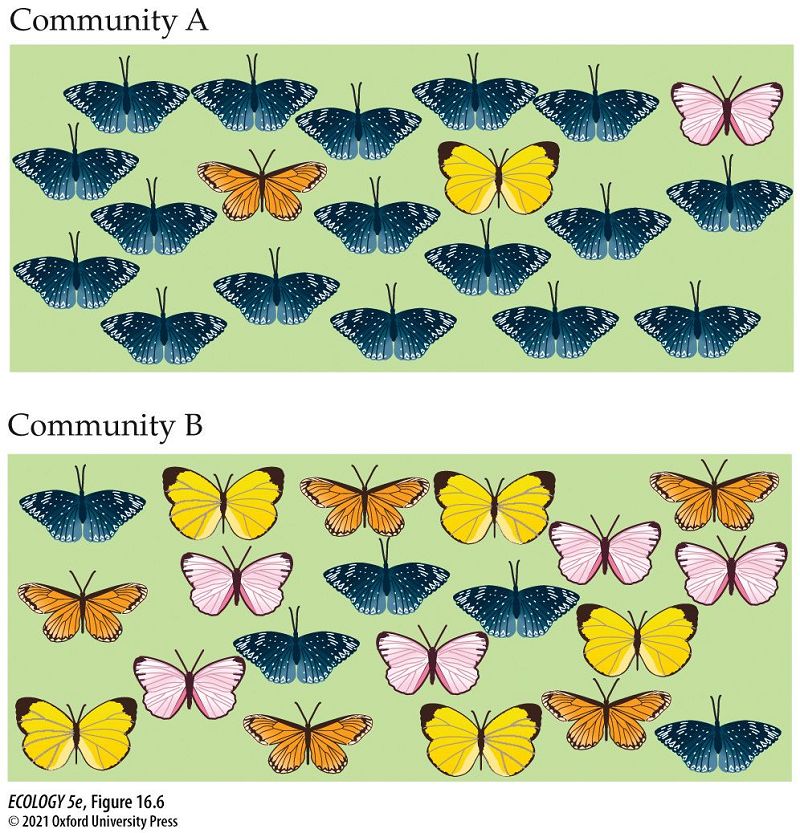
What is the key message from this diagram?
Even though the two communities have the same number of species, Community B has higher diversity because the abundances of species are more even
Even though the two communities have the same number of species, Community A has higher diversity because of its high abundance of the blue butterfly
The pink butterfly is more abundant in Community B
Because the two communities have the same number of species, they have the same diversity
What was Darwin's hypothesis about the relationship between cats and pollination?
Because cats eat mice and mice eat bees, cats harm plant pollination
Spending their time chasing cats, bees have less time to pollinate flowers
Because cats eat mice and mice eat bees, cats benefit plant pollination
Cats are an important predator of bees so they harm plant pollination
What is succession (in an ecological context)?
The change in a community's species composition through space
The ordering of species from smallest to largest in an ecosystem
The ordering of species from smallest to largest in a trophic level
The change in a community's species composition through time
If an abiotic driver of ecological succession is classified as a stressor, it is:
High intensity
Low intensity
What are the two key processes of ecological succession?
Direct and indirect interactions
Local extinction and colonization
Local colonization and reproduction
Local population growth and niche partitioning

What is the key message from this figure?
Ulva facilitates the growth of Gigartina
Gigartina inhibits the growth of Ulva
Gigartina facilitates the growth of Ulva
Ulva inhibits the growth of Gigartina
Can communities undergo reverse succession?
Yes, disturbances can move communities backwards on the successional trajectory
No, once a community begins succession it proceeds until the climax community is reached
How can species interact during succession to affect the succession process?
Facilitation, tolerance, inhibition
Predation, no effect, facilitation
Mutualism, predation, tolerance
Dispersal, facilitation, predation
In the context of ecological communities, what is an alternative stable state?
When different forms of succession led to the same community composition
When similar conditions produce different community compositions
When two or more species can exist in the same community
Primary succession might occur:
If/when humans cultivate ecological communities on the moon
After a volcanic eruption
All options are correct
After a glacier retreats
What happens to species richness as a larger and larger area is surveyed?
It stays the same
It increases
On islands, what two processes determine species richness?
Island isolation and size
All factors determine species richness
Island predators and temperature
Island temperature and size
Species richness on islands is the balance between what two processes?
Emigration and population growth
Speciation and extinction
Speciation and population growth
Immigration and extinction
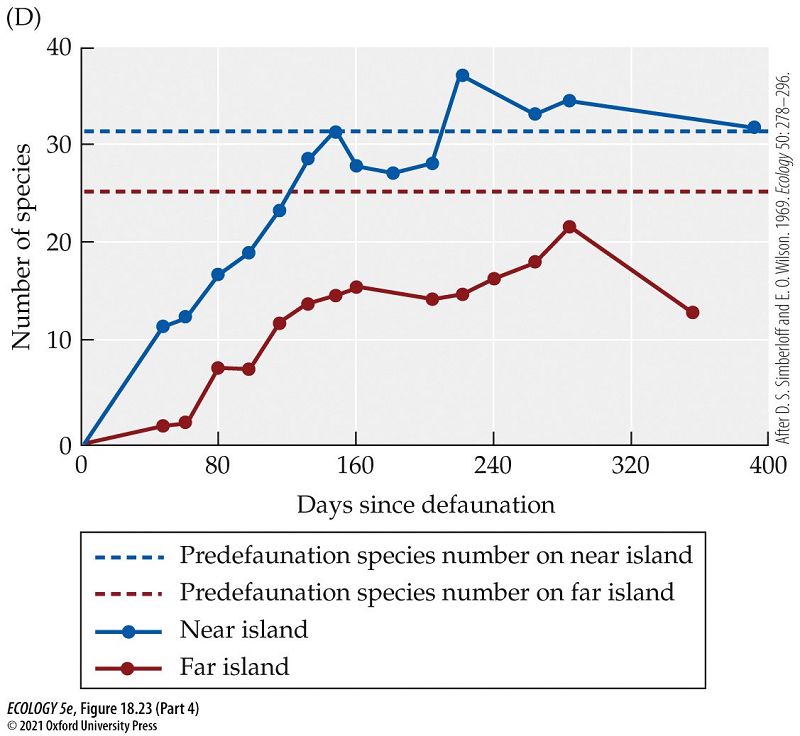
What is the key message from this figure?
Both messages are equally important
Species richness recovered in the near island but not in the far island
The near island always has more species than the far island
In general, which part of the planet has the highest species richness?
Species richness is even across latitudes
Tropics
Temperate zone
Near the poles
Which is not an explanation for tropical diversity?
Species diversification rates are higher in the tropics
The tropics have higher productivity
The tropics have more biomes
Species have had longer to diverge in the tropics
What are the six main biogeographical regions closely associated with?
Patterns of human migration
Three air circulation cells in each hemisphere
Latitudinal rainfall patterns
Major tectonic plates
What is the correct order of species diversity metrics from local to regional?
Gamma, beta, alpha
Alpha, gamma, beta
Alpha, beta, gamma
Beta, gamma, alpha
What factors comprise a species' niche?
Effects on other species
All listed options comprise the niche
Habitat requirements
Food requirements
What is the key determinant of whether competition actually occurs or not?
The size of the fundamental niche
Whether the species want to compete
The diversity of the community
Resource availability
What is character displacement?
None of these
The interference competition that occurs between competitor species
The avoidance of one species by the other
The divergence of two species' morphology when they cooccur compared to when they occur alone
Can competition occur within a species?
Yes, this is density-dependence
No, competition only occurs between different species
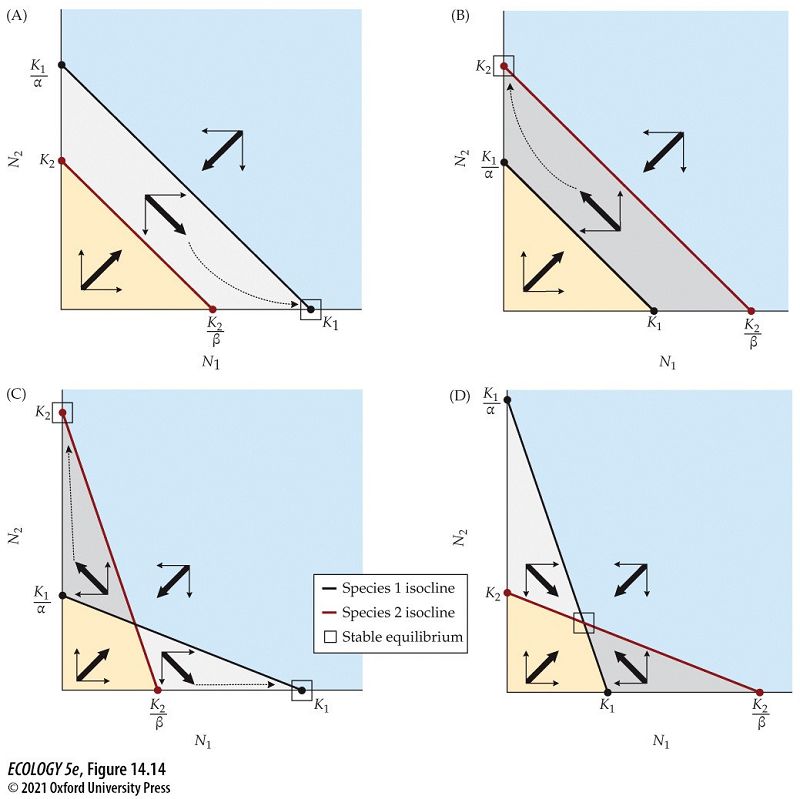
In which of these situations do both species coexist?
B
C
D
A
What is added to the logistic equation to include interspecific competition?
Carrying capacity
The logistic equation already accounts for interspecific competition
The total amount of resources available
The population size of the competitor and its effect on the focal species
Is the outcome of competition typically even?
No, one species tends to be the dominant competitor
Yes, species tend to have the same ability to compete with each other
Which is larger, the fundamental or realized niche?
Fundamental
Realized
What drives the population cycling of lynx and snowshoe hares?
Non-consumptive effects of lynx on hares via induced stress
Food availability for hares
Direct effects of lynx eating hares
All of the listed factors contribute
What is a parasitoid?
An animal that is a parasite some of the time
A parasite that lives on the outside of the host
An animal that lays its eggs inside the body of another species
Which animals eat higher calorie foods?
Herbivore
Carnivore
What is the difference between constitutive and inducible plant defenses against herbivores?
Constitutive defenses are always there, inducible defenses occur when herbivory happens
Constitutive defenses are better for mammalian herbivores, inducible defenses are better for insect herbivores
Constitutive defenses depend on herbivory occurring, inducible defenses do not
What new parameters are added to population models to model predation?
All of these parameters are added
Predator mortality rate
Prey capture rate
Conversion efficiency from prey to predators
What's the difference between obligate and facultative mutualism?
Facultative mutualisms are when the two species must engage in the interaction to survive/reproduce; obligate mutualisms are when the species do not need to engage in the interaction to survive and reproduce
Obligate mutualisms benefit both species but facultative mutualisms only benefit one species
Obligate mutualisms are when the two species must engage in the interaction to survive/reproduce; facultative mutualisms are when the species do not need to engage in the interaction to survive and reproduce
Obligate mutualists only live inside their mutualist partner
What benefit do mycorrhizal fungi provide to plants?
Energy from the soil
They provide no benefit but do no harm to plants
Nutrients and water from the soil
They provide no benefit and are parasites of plants
How does a commensalism differ from a mutualism?
In a commensalism, both species are positively affected
In a commensalism, one species benefits and the other is negatively affected
In a commensalism, one species benefits but the other is not affected
In a commensalism, both species are negatively affected
When do mutualists engage in their interaction?
Mutualists always engage in their interaction
When the costs of the mutualism are outweighed by the benefits
Whenever both species are found in the same place
When the costs of the mutualism equal the benefits
What is cheating in the context of mutualisms?
When one partner in the interaction also engages in mutualisms with other species
When one partner in the interaction obtains the benefit without fulfilling their role in the mutualism
When one partner does its job in the mutualism but is not well adapted for the mutualism
When one sex of a species has a mutualism with all sexes of the other species
Which of the below taxa are engaged in a mutualism with plants?
All of the listed taxa have mutualisms with plants
Frugivorous seed-dispersers
Pollinators
Mycorrhizal fungi
What is does the fig wasp gain in its mutualism with figs?
A meeting point for mating
A safe, nutritious place to lay eggs
A source of magnesium
Nectar to feed on
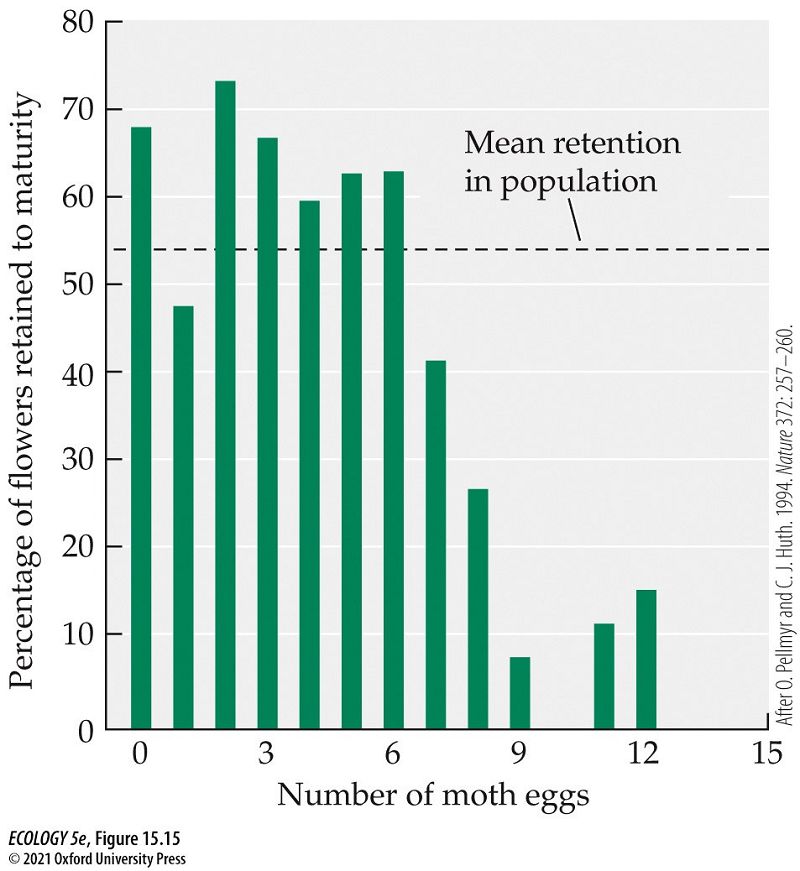
What is the key takeaway from this figure on the Yucca mutualism with yucca moths?
Yuccas keep about 55% of their flowers to maturity
Yucca moth lay a maximum of 12 eggs
When yucca moths lay too many eggs, the Yucca plant aborts those ovaries to prevent cheating in the mutualism
What is an ectoparasite?
A parasite that lives on the outside of its host
A bacterial, viral, or fungal parasite
A worm or arthropod parasite
A parasite that lives on the inside of its host
Which of the options is a disadvantage of endoparasitism?
More exposed to the environmental conditions
More vulnerable to immune system
More vulnerable to their own predators and parasites
Harder to feed
Which is a type of a defense that plants have against parasitism?
Plants do not suffer from parasites
Leaf shaking to dislodge parasites
Plants cannot defend themselves from parasites
Production of anti-bacterial and anti-fungal chemicals
How can pathogen spread be controlled?
Reducing the density of susceptible individuals
All of the above
Greater recovery rate
Reduced transmission rate
Parasites interact with their hosts, but can they influence other species interactions?
Yes
No
What is a parasite?
A predator but small
Any species that lives inside another species
A species that negatively affects other species by competing with them for resources
A species that lives in close proximity with its prey and feeds on its body tissue without killing it instantly

What is the main takeaway from this figure?
There are five aphid genotypes
Some aphid genotypes have symbionts others do not
Even in the best case scenario, aphids have low survival rates
Symbionts increase aphid survival in the face of parasitism
What causes population cycles in nature?
Parasites
Predators (and fear of predators)
All of the options
Food scarcity
In which system is it hardest to observe cycling of predator and prey populations?
Experimental
All systems are equal
Natural
Mathematical
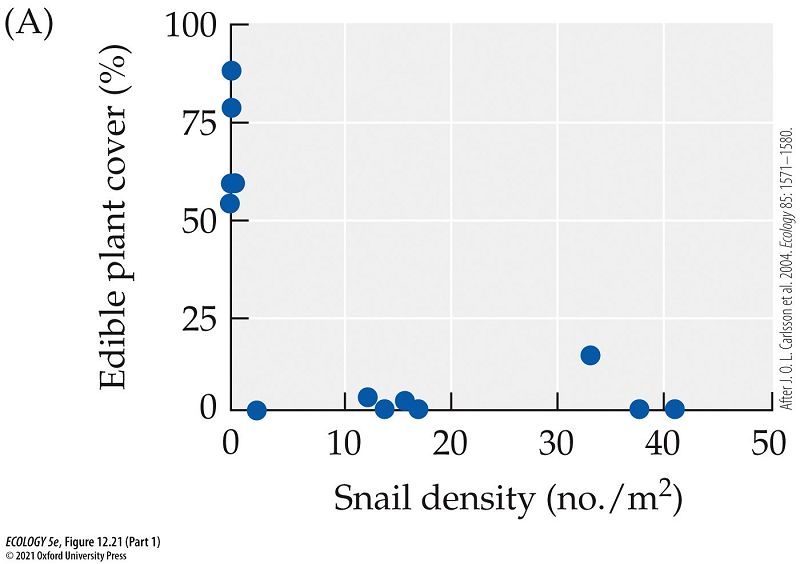
What is the key message of this figure?
Plant cover tends to be either above 50% or below 20%
Snails do not reach more than 50 snails per square meter
Snails can exist at different densities
Plants are only common if there are no snails
What is the purpose of mast seeding by plants?
To overwhelm seed predators and ensure some seeds survive
To produce lots of seedlings at once to increase competition and ensure the best survive
To use up stored energy
To move the community forward in the successional trajectory
{"name":"BIO 148 Midterm 2", "url":"https://www.quiz-maker.com/QPREVIEW","txt":"Prepare for your BIO 148 Midterm 2 with our comprehensive quiz! This quiz consists of 69 carefully crafted questions that cover key concepts in ecology, evolution, and behavior. Whether you're reviewing for your exam or seeking to enhance your understanding of biological principles, this quiz is designed to help you succeed.Test your knowledge on life histories and ecological communities.Explore topics like species interactions, reproduction, and succession.Understand the principles that govern biological diversity and ecosystem dynamics.","img":"https:/images/course3.png"}
More Quizzes
Honors Bio GP
13610
Science lesson: 1
10525
General knowledge and trivia
1476
The Ultimate Fun Quiz
9418
Ultimate Song Trivia - Do You Know These Hits?
201049284
Why Are You Single: Discover What's Holding You Back
201030247
Is My Mom Manipulative: Spot the Signs Now
201023942
Heart Structure: Test Your Cardiac Knowledge!
201045357
Central America Trivia: Test Your Knowledge
201055416
Ultimate Melanie Martinez: Test Your Fan Knowledge
201063518
Free Prueba 4a-4: Asking Questions Answers
201026645
Free Mitochondrial Biology & Metabolism
201021685